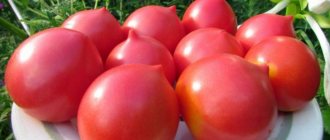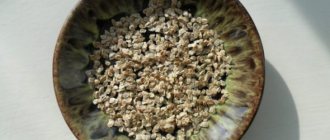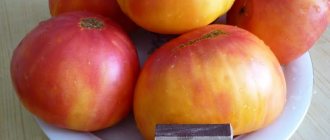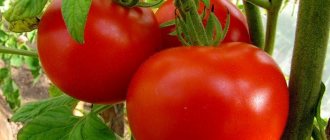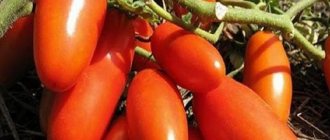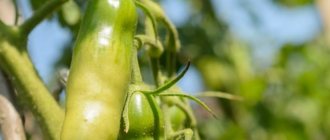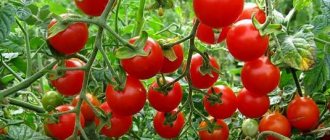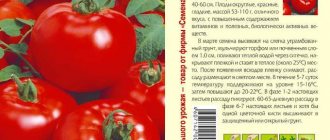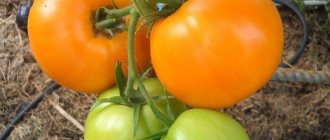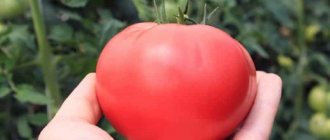Vegetable growing » Tomatoes
0
1353
Article rating
Kira Stoletova
Hybrids are plants specially bred to obtain a specific set of characteristics, such as fruit weight and color, and disease resistance. This group of plants includes the Slastena tomato and its variety f1 Nastya-slastena.
Characteristics of tomatoes of the Nastena-slastena variety
"Have a sweet tooth"
The one who packed the seeds, providing information, describes that the variety is mid-season, high-yielding and suitable for growing in protected soil and under film covers.
However, vegetable growers successfully grow sweet tomatoes even without shelter. A photo of the bush indicates that the plant is tall, up to 180-200 cm in height, indeterminate, and has average branching.
The fruits hang in beautiful clusters of 30-40 pieces. The tomatoes are round and red (although the packer also indicates all other possible colors). Tomato weight is within 3035 g.
What does the register of breeding achievements offer the market from small-fruited and sweet tomatoes?
Features of growing tomatoes, planting and care
Sowing seeds for seedlings is carried out 55-60 days before the intended planting in the ground. Picking seedlings - at the stage of 2 true leaves. When transplanting seedlings to a permanent place, 1 sq. It is recommended to place up to 6 plants per meter of land. Planting pattern: 70 x 30-40 cm.
Further care for tomatoes consists of timely watering, fertilizing with complex mineral fertilizer, and preventive measures to protect the crop from diseases and pests.
How to form determinate tomatoes, video
"Sweet tooth"
The tomato was presented to vegetable growers by Agrofirma Sedek LLC, Moscow region.
The registration commission recommends growing the variety in all regions of the country, both in open ground and under temporary film greenhouses.
Salad and whole-fruit tomato.
The plant is very tall and requires timely pinching and tying. The leaf of the vegetative form is small, dark green in color. Tomatoes are well illuminated by the sun and can fully absorb its rays in order to accumulate the required amount of sugars.
The plant is early ripening and soon after transplanting into open ground it begins to please the vegetable grower with fruits. Fruiting is long and extended; you can enjoy sweet tomatoes until late autumn
The fruits are round, even, weighing 35-40 g. The tomato skin is smooth, not dense in consistency. The red, rich color makes the bunches very attractive.
The taste of tomatoes corresponds to the name.
Productivity is within 4-5 kg per square meter. m.
Advantages:
- early maturation;
- long fruiting;
- good taste;
- high product yield;
- product uniformity.
Description of the variety: history and characteristic features
Slastena tomatoes were bred in 2000 by breeder Valentina Redko, well-known in gardening circles. The tomato was in the State Register of Breeding Achievements for a long period. But today there is no variety with that name. He returned to the amateur category. Another tomato is produced under the same name. The agricultural company Ural Summer Resident called its development cherry.
The Slastena tomato is known for its tasty, very sweet fruits of medium size and weight. The plant was intended for cultivation exclusively in open soil in the Urals. Over time, it was adapted for greenhouses and informally zoned into other regions. Bush characteristics:
- medium sized leaf;
- the stalk has an articulation;
- the inflorescence is simple.
| According to ripening time | By type of growth | By type of use | By growing method | Fruit weight (g) | Productivity (kg/m2) | Ripe fruit color | Fetal characteristics |
| Early ripe (90-95 days) | Semi-determinate-minant (about 1 m outdoors, 1.3-1.5 m in a greenhouse) | Universal | For open ground and greenhouses of any type | 60-120 | 10-12 in a greenhouse, 8-10 in garden soil | Red | Shape - ellipse, surface without edges, from 2 slots |
This is interesting: Big Girl pepper - description of the variety and cultivation characteristics
"Sweet Pearl"
The variety was presented to the market by LLC Agro Moscow in 2015.
It is recommended to grow tomatoes both under film covers and in open ground. The medium-ripening variety is suitable for fresh consumption and processing.
The growth force of the vegetative form is powerful. The plant requires formation and regular tying.
The variety is called pearl for a reason. Its fruits are very small, within 5 g, and have two nests. They look great as a decoration on cold appetizers and canapés, and are fun for children.
Tomatoes have a good taste, sweet and aromatic.
The yield of the variety is within 7-7.5 kg per meter of garden area.
Advantages:
- good taste;
- unique size;
- high yield.
Characteristics
Fully ripe fruits are bright red, even burgundy. The shape is a classic small cherry, slightly elongated, but not much. The skin is dense, glossy, the flesh is plastic and fleshy. The palatability is high, the taste is pleasant, honey-sweet, typical of good cherry tomatoes. The fruits are mostly small, from 30 to 50 grams; at the first harvest they can reach 70 grams. Number of chambers 4, dry matter content 6%. A ripe harvest satisfactorily withstands long-term transportation and ripens well if harvested a little earlier than expected.
Small and sweet cute fruits “Nastya Slastyony” are ideal for prefabricated canning. These tomatoes are not suitable for barrel pickling. When fresh, it is good to use in first courses, in combination with other vegetables. Due to the high content of vitamins and balanced taste, they make a very healthy and tasty juice. Can be processed into ketchup and lecho.
You can compare the weight of the fruits of this variety with others in the table below:
| Variety name | Fruit weight |
| Nastya has a sweet tooth | 30-70 grams |
| The president | 250-300 grams |
| Summer resident | 55-110 grams |
| Broody | 90-150 grams |
| Andromeda | 70-300 grams |
| Pink Lady | 230-280 grams |
| Gulliver | 200-800 grams |
| Banana red | 70 grams |
| Nastenka | 150-200 grams |
| Olya-la | 150-180 grams |
| De Barao | 70-90 grams |
"Sweet Bunch"
The originator of the variety is Agrofirma Sedek LLC, Moscow region. The tomato entered the register in 2009 and has already gained popularity.
The variety is recommended for all regions of the country for greenhouses, greenhouses and private gardens as an early ripening salad product. The surplus is perfect for canning, either on its own or as an assortment with other vegetables.
The plant form is tall, indeterminate, the leaves are very large.
The fruit is round, dense with a smooth red skin.
Tomatoes with an average weight of about 30 g and two seed cavities filled with juice and small seeds.
The yield of the variety is not high up to 3 kg, but the wonderful taste compensates for this shortcoming.
Description of the tomato variety Nastya-slastena
The planting location for the Nastya-slastena tomato variety is selected depending on the growing region. In the south, all the fruits have time to ripen on ordinary ridges, but in regions with a harsh climate it is better to plant them in greenhouses or greenhouses with temporary film cover.
According to the description, the tomato Nastya-sweetness F1 is a hybrid, so collecting seeds is out of the question. The plant is early ripening, ripening occurs on the 95-105th day from germination.
Hybrid Nastya is a tall, indeterminate type. There are few leaves on the bushes, they are simple, tomato-like, dark green in color. A lot of stepsons grow, but the crop must be formed on 2-3 stems.
The Nastya-sweet tomato stands out with complex peduncles on which there are many small flowers. Inflorescences are located throughout the stem. Almost all flowers are set, so the cluster consists of 35-40 oblong-shaped fruits.
Important! The first flower cluster appears above the 8-9 leaf, when the seedlings are still standing on the window.
Description of fruits
Tomatoes of the Nastya-slastena variety are small, cherry-type, their weight is 20-30 g. Ripe tomatoes are deep red. The oblong fruits are dense, hold tightly to the peduncles, and do not fall off even when overripe. Tomatoes are prized for their crumbly, sweet pulp. According to reviews, the Slasten tomato has a honey flavor, which attracts children to the garden beds.
Small tomatoes have 4 seed chambers. The sugary pulp is located under the thick skin.
"Sweet Girl F1"
The earliest hybrid of all small-fruited ones. The Moscow region introduced seeds to the market back in 2008.
The yield of the hybrid is not high, but the rapid supply of small tomatoes makes vegetable growers very happy, and therefore it remains in demand.
The hybrid owes its super precocity to determinacy. Low-growing bushes begin to lay their fruit clusters even in the seedling period, and once in open ground they begin to ripen quickly.
The yield of a commercial tomato is stated at the level of 3.5-4 kg, but the bushes bearing fruits weighing 10-20 g seem strewn with small red “olives”. The fruit has an ellipse shape, smooth, shiny skin and good density.
Housewives fell in love with this variety because it behaves impeccably during heat treatment. Once in a tin can, it fills it very tightly, and the finished product will compete with olives on the holiday table.
The taste of fresh tomatoes is rated “excellent”, while canned tomatoes are simply impeccable.
Advantages
- very early ripening;
- short stature;
- excellent taste;
- interesting shape;
- impeccable canning properties.
Characteristics and description of the tomato variety Slastena, its yield
The variety was created in Russia in 2000, included in the State Register of Breeding Achievements in 2008. In the south, the Slasten tomato is planted in open ground; in Siberia, the Urals, and the Far East it is planted under film. This is an early variety: 90–95 days pass from planting seedlings in the ground to picking ripe fruits.
general information
Description of the variety - indeterminate bushes, standard, up to 1 - 1.1 m in height in a summer cottage, up to 1.3 m in greenhouses. The foliage is sparse, the leaves are medium-sized, dark green. The first brush appears above the 8th - 9th sheet, the subsequent ones - every 3 sheets. There are 30 - 40 tomatoes on one brush.
Characteristics of the fruit: slightly elongated, cylindrical in shape. Ripe tomatoes are scarlet and burgundy. They have thick skin. Sweet, with a honey aftertaste. Fruit weight - 30 - 50 g, on the first clusters - up to 70 g. There are 4 seed chambers, the presence of dry matter is 6%. They are eaten fresh, put in salads, canned, juiced, made into ketchup and lecho. Not suitable for barrel pickling.
Advantages and disadvantages
Tomatoes have a number of advantages:
- small sweetish tomatoes;
- the skin does not burst;
- tie together;
- the variety is resistant to sudden temperature changes;
- tomatoes ripen quickly;
- easy to transport;
- the yield is high: up to 2 - 2.5 kg of fruits are harvested from a bush, up to 8 kg from 1 m², and up to 10 kg in a greenhouse;
- bushes can grow even on depleted lands;
- are stored for a long time;
- the variety is moderately resistant to brown spot, root rot, and late blight;
- good for canning.
Among the small disadvantages are that the bushes need to be tied up, the stepsons need to be torn off, and the branches need to be propped up.
Sowing seeds
Tomato seeds of the Slastena Nastya F1 variety are sown at the end of March. If you purchased seeds at the market, they are disinfected. The seeds are poured into a gauze bag and left for 20 minutes. into a solution of potassium permanganate (pour 1 g into half a glass of clean water). It is not recommended to keep seeds in potassium permanganate for longer than 20 minutes, as their germination rate decreases. Then rinse the seeds with clean water.
Make soil from equal parts of peat soil, turf soil, and humus. Add 1 teaspoon of superphosphate, urea, and potassium sulfate to one bucket of prepared soil. Disinfect the soil by spilling it with a strong solution of potassium permanganate. Then let the soil remain moist for 10 days to allow beneficial bacteria to multiply.
Place the seeds in the soil. Sprinkle with soil so that the seeds are buried 1 cm. Water with a spray bottle. Cover with film and place in a warm place. The air temperature should be 25 - 30 degrees.
Growing seedlings
When shoots appear, remove the film. Place the box on the windowsill. Seedlings are picked when 2 true leaves appear and transplanted into peat cups. To grow seedlings in the absence of sun, illuminate them with lamps.
Water the seedlings with a spray bottle in the morning. 2 weeks before transplanting, begin to harden the bushes by taking them out onto the balcony. First, place them on the loggia for 5 minutes, then increase the interval the seedlings are in the open air.
Transplanting
In the fall, spread 4 kg of manure onto 1 m² of land and dig the soil to the depth of a shovel. In the spring, scatter the same amount of manure over the soil, but the manure must be rotted. Also sprinkle 1 tbsp per 1 m² of soil. a spoonful of potassium chloride and 5 tbsp. spoons of superphosphate. Dig the soil a second time. Although, in general, this variety is not picky about the composition of the soil.
Dig holes with a diameter of 15 cm and a depth of 30 cm. Drive in pegs. Place the seedlings into the holes. 4 bushes are placed per 1 m², doing this in a checkerboard pattern. Water the plantings thoroughly. Tie up the bushes.
Feed the tomatoes for the first time 10 days after planting on the site. Pour 1 kg of manure into a ten-liter bucket of water. Let it sit for a while. Then water, being careful not to get it on the leaves. Fertilize at the same time as watering. After each watering or rain, loosen the soil. After the first fertilizing, mulch the ground with straw and pine needles in a 5 cm layer.
Diseases and pests
Be sure to take preventative measures. Ventilate the greenhouse daily. The variety tolerates sudden temperature changes well, but it is better to monitor the temperature in the greenhouse.
"Sweet Baby"
An early-ripening varietal novelty was presented by Euro-Seeds LLC, Moscow in 2015. The variety successfully passed the test and was recognized for cultivation in all regions of the country in vegetable gardens and vegetable gardens.
The plant is tall and requires attention and tying up.
The fruits are red, small, and weigh no more than 8 g. They taste very sweet, with a pleasant aftertaste. Round shape, tender skin, two seed nests.
The yield of the variety is within 3.5 kg/m2 of garden area.
Caring for tomato seedlings
When two pairs of leaves appear on the sprouts, the plant is pruned.
There are several more rules for caring for sprouts:
- Seedlings should receive plenty of light.
- It is necessary to maintain a certain temperature.
- As the top layer of soil dries, it is important to water.
It is impossible to moisten the plantings too much: excess moisture leads to rotting of the leaves, and this is fraught with diseases.
Landing at a permanent place
Plants need staking
In the southern regions, tomatoes are planted in open ground. Before this, the seedlings are hardened off for two weeks. On the first day, the plants are exposed for half an hour. The second time it is increased again and so on.
When grown in greenhouses, plants will not need hardening. They are simply carefully removed from the nurseries and then delivered to the greenhouses.
The land needs to be marked out so that there are 4 bushes per 1 m². They are planted in a checkerboard pattern. A handful of ash is added to the holes, after which they are watered with warm water. Strong supports or trellises are installed near each hole.
Sufficiently tall sprouts are immediately tied up. The soil near the stems is mulched. Finely chopped straw or dark film is suitable for this.
Bush care
The main components of care are:
- watering;
- weeding and loosening;
- extermination of insects and slugs;
- disease prevention.
Plantings are watered once a week. Do this with warm water. After watering, loosening is carried out to prevent the soil from forming a crust when drying.
Lime is sprinkled in passages and paths to repel slugs. To kill small insects, broad-spectrum insecticides are purchased.
Fertilizer
For the first time, plantings are fertilized after the plants have taken root. Complex mineral fertilizers applied by spraying bushes are suitable for this. Foliar feeding can be carried out until the first cluster forms. The time between feedings is 15 days.
Organic mixtures are prepared independently.
- Take a large container.
- Fill it halfway with rotted mullein or bird droppings and add water.
- Keep the mixture warm for two weeks, stirring occasionally for better fermentation.
- The finished substance is diluted with warm water in a ratio of 1:10 and watered at the roots of the plants.
The varieties are practically not affected by late blight, gray mold, powdery mildew and other viruses, but it is better to treat them for prevention. Fitosporin, Bravo, Aktaru and other chemicals are used.
Grape warming
To increase the length of the mature vine, it is sometimes necessary to carry out autumn pruning in two stages. First…
Autumn pruning of grapes
Hello. A strange beetle has tormented us. This parasite destroys the buds of inflorescences during flowering...
This nasty stag beetle
Recently I was at an exhibition and saw how sellers exhibited a vine with an unusually large bunch (variety…
"Sweet Fountain"
Reputable Agrofirm Poisk LLC, Moscow region. Vereya village and the Federal Scientific Center for Vegetable Growing, Moscow region, in 2015, after lengthy varietal tests, introduced a tomato hybrid to the market, which has a number of undeniable advantages.
The tomato is recommended for all regions of the Russian Federation for growing in protected soil. Having planted tomatoes in a greenhouse, you must immediately take care of fixing and tying them up, since the plant will quickly begin to grow and its strength is great.
An early ripening plant with a medium leaf.
The fruits are elliptical in shape, very small, not exceeding a weight of 20 g. The tomato skin is smooth, of medium density. At the ripening stage, the fruits have an extensive green spot at the base. Moving into the phase of biological maturity, the stain disappears.
The tomato has two seed nests with small seeds.
The taste of small tomatoes is excellent. The fruits are sweet, pleasant and aromatic.
The product yield is within 7 kg per square meter.
The hybrid is highly resistant to most tomato diseases, including such dangerous ones as Fusarium wilt.
Short description
Before you start growing Sweet Tooth, you should familiarize yourself with its distinctive features. The characteristics and description of the variety will help you learn a lot of useful information about it.
Slastena refers to early-ripening tomatoes, which manage to fully ripen one and a half months after planting young seedlings in the soil. Under good conditions, bushes can grow up to one and a half meters, so it is recommended to tie them to special supports that will prevent the bushes from breaking. Sweet Tooth also needs stepsoning. To get a good harvest, you should form a plant with 2-3 stems.
Ripe tomatoes have a round shape and a bright red color. Their weight is not too large and is only 100-150 grams. They have excellent taste, which is why they are often used in cooking. Tomatoes are often used to make canned food and various vegetable salads.
"Sweet Million"
Considering the sweet tomato series, reviews, photo yield, one cannot help but consider the tomato, which has long been heard by vegetable growers due to its merits.
Thanks to Agrofirma Aelita LLC, Moscow, in 2001 the variety was entered into the register and recommended for all regions of the Russian Federation. Both farmers and vegetable growers can grow the variety in their garden plots under film covers.
The variety is early, on the 100th day after germination you can start enjoying the ripened fruits. Salad, small-fruited tomato up to 20 g can be used both as salad products and for canning.
The plant, although indeterminate, is of medium height and rarely grows above 150 cm. The first inflorescence is formed above the 8th leaf, and then after 1-2.
The fruit formation is round and smooth, red-scarlet in color with 2-3 nests.
The taste of the tomatoes is excellent, balanced, aromatic with a slight piquancy, which makes the tomato recognizable.
The yield of the variety is within 7 kg per meter of greenhouse area.
The plant is very resistant to the main contagious diseases of tomatoes.
Advantages:
- early ripening of the crop;
- excellent taste;
- compactness of the vegetative form and brush;
- maturation is friendly and generous;
- disease resistance.
Growing rules
The agricultural technology of the Nastena-slastena tomato, according to reviews from those who have been involved in the crop for a single year, is practically no different from other varieties:
- growing seedlings;
- landing in a permanent place;
- watering and weeding;
- loosening the soil and mulching;
- feeding and protection from diseases.
Planting seedlings
Tomatoes of the Nastya-slastena variety are best grown in seedlings, despite the early ripeness of the plant.
Sowing is scheduled for mid-March or early April. It all depends on the climatic conditions of the region. You just need to count 60 days from the intended planting of seedlings in a permanent place.
Preparing containers and soil
You can plant seeds in different ways:
- into containers;
- into the snail;
- in peat pots or tablets.
You can take ready-made soil or prepare it yourself. You need to take equal parts of ordinary soil and humus, add sand and wood ash.
Before sowing tomato seeds, the container and soil are spilled with boiling water, adding several crystals of potassium permanganate to it. This is a necessary measure for the prevention of fungal diseases and the destruction of pests.
Sowing seeds and caring for seedlings
Before planting, seeds are soaked for 30 minutes in a pink solution of potassium permanganate or in any growth stimulant in accordance with the instructions.
The seed is buried 1 cm. The distance between the furrows is 3 cm. The soil is moistened, the container is covered with film and placed on a lighted window. The best temperature for seed germination is 22-24 degrees. When the first shoots appear, the film is removed.
Further care for Nastya-slastena tomato seedlings comes down to watering and superficial loosening of the soil. You can feed the plants with a solution of wood ash.
Comment! Under no circumstances should excessive watering be allowed, as this may cause damage to the root system by blackleg.
Dive
Transplanting tomatoes is a necessary condition for obtaining plants with a powerful stem and a well-developed root system.
When the 3rd leaf appears on the Nastena-slastena tomato, it’s time to pick. It is advisable to use the same soil as when sowing seeds. The seedlings are watered and selected with a clod of earth. Make a hole in the pot and place the seedling up to the cotyledon leaf. After transplanting, water the soil with warm water.
2 weeks before planting in a permanent place, seedlings of the Nastya-slastena variety are hardened off. They are taken outside and gradually accustomed to new conditions. As a rule, at the time of planting, the bushes have the first cluster of green fruits.
Transfer
If the greenhouse is heated, Nastya the Sweet Tomato seedlings can be transplanted into it in mid-May. As usual - in early May. These terms are approximate, since they depend on the climate zone in which the gardener lives.
Seedlings can be planted in open ground after a stable positive temperature has been established. And, most importantly, the morning frosts will not return.
Planting pattern for tomatoes Nastya-slastena 30x50 cm in a checkerboard pattern.
Landing rules
The holes are prepared 14 days before planting so that the soil has time to settle. You need to add humus to each hole and pour it well with hot water and potassium permanganate.
Attention! Nastya does not recommend fresh manure for fertilizing tomato seedlings, as it promotes the growth of green mass.
The seedlings are watered to make it easier to remove from the cup. Plant in the center of the hole, compact the soil and water.
Important! The leaves under the first brush need to be torn off to speed up the establishment of seedlings.
Aftercare
The formation of Nastya-sweetness hybrid bushes is carried out after 2 weeks, when the plants take root. The best harvest is obtained on bushes grown in 2 or 3 stems. Stepchildren must be removed throughout the growing season.
The description says that the Slastena tomato is a tall plant, so you will have to take care of tying it up. To do this, immediately after planting, install long stakes or stretch a trellis. It is necessary to tie not only the stems, but also the brushes themselves, as they can break off under the weight of the fruit. The first time they grab the stem at a level of 20-30 cm.
All other activities are the same as for other tomatoes: watering, loosening, removing weeds, mulching and fertilizing.
To feed the bushes, you can use an infusion of mullein, chicken droppings, and green grass. Wood ash is sprinkled under each bush as a top dressing and prevention against diseases. It is useful to sprinkle the leaves with this substance.
You shouldn’t forget about foliar feeding either. The Nastena sweet variety responds well to boric acid and iodine. This is not just additional nutrition. The plants' immunity is strengthened, the fruits fill and ripen faster.
"Sweet Meeting"
The variety was presented to vegetable growers by Agrofirm Poisk LLC, Moscow region. Vereya village and Federal State Budgetary Institution "Federal Scientific Center for Vegetable Growing" Moscow region. After the trials, in 2015 the variety was entered into the varietal register of the Russian Federation.
All regions of the country can take advantage of the breeders’ gift to grow tomatoes under film cover.
The plant is determinate, however, it requires staking and shaping, since the bushes tend to become very thick and turn into wilds, although its foliage is small.
An early ripening variety for salad purposes.
The fruit is very small, about 17 g. Small-fruited pink tomatoes are quite rare and this variety is one of the few that pleases with its color.
Tomatoes have two nests, the fruits are round with smooth skin and medium in density
The tomatoes taste very good. The balance of acid and sugar makes them desirable to taste again and again.
The marketable yield of the variety is about 5 kg/sq.m. m.
The variety is resistant to tomato diseases and does not require additional treatments.
Advantages:
- excellent taste;
- pink, rare color;
- disease resistance;
- early ripening of products;
- not a great height.
When describing a series of sweets, one cannot fail to mention tomatoes, which have an interesting color, but are just as small and sweet as their “brothers”.
Slasten's tomatoes
Tomatoes of the Slastena variety in the southern regions of Russia can be grown in open ground; in the rest of the territory it is recommended to plant them in greenhouses or under temporary film covers.
Description of the bushes
The plant is indeterminate, standard, and belongs to the early ripening varieties. After planting in the ground, the fruits can be harvested after 90-95 days. The height of the Slastena tomato, according to the description, in open ground reaches 100-110 cm, in a greenhouse it is about 130 cm.
The foliage is medium, the leaf blades are deep green and small. Place the first flower brush on the 8th-9th leaf. All subsequent inflorescences are formed through two or three leaves. The brushes are powerful, each of them bears up to 40 fruits.
Description of fruits
The tomatoes of the Slasten tomato are round-flat in shape. When unripe, the fruits are juicy green in color; when ripe, they are scarlet-burgundy. The skin is quite dense, but not tough. Each fruit weighs from 30 to 50 grams.
Important! The largest tomatoes are formed on the lower cluster. The pulp is sugary, with four seed chambers, the same as the taste of the tomato itself
The aftertaste is honey. Fruits with thick skin. They contain 6% dry matter
The pulp is sugary, with four seed chambers, the same as the taste of the tomato itself. The aftertaste is honey. Fruits with thick skin. They contain 6% dry matter.
The use of the variety is universal. Fresh fruit salads, tomato juice, ketchup and lecho are very tasty. You can preserve it in jars, but barrel pickling is not for this variety.
Characteristic
According to the description of the variety and reviews from gardeners, the Slastena tomato has many advantages:
- Sweet as candy, tomatoes with thick skin do not crack.
- Setting is almost 100%, ripening is extended.
- The variety tolerates temperature fluctuations steadfastly.
- Presentation is preserved during long-term transportation
- Slasten's tomatoes, according to reviews and photos presented, are high-yielding. One bush yields up to 2.5 kg, about 8 kg per square meter in open ground, and up to 10 kg in protected ground.
- Good yield even on poorly fertilized soil.
- Tomatoes are distinguished by their excellent keeping quality and ability to ripen.
- The variety is resistant to many diseases of nightshade relatives, in particular, it practically does not suffer from late blight, brown spot, root rot, verticillium, and fusarium wilt is rarely observed.
- Since the packets do not have the letter F1 on them, you can collect your own seeds.
Gardeners do not indicate any disadvantages as such in the reviews. The only drawback is the presence of a large number of shoots that have to be constantly pinched, and the need to tie up the bushes due to the abundant fruiting.
About the Slastena tomato:
"Zelenushka F1"
The name of this hybrid, most likely, was not very attractive to the packer and it was renamed the “Green Sweet Tomato” tomato.
The hybrid was entered into the register in 2007, and its originator is Selection and Seed Agro Moscow Region LLC. Mytishchi.
The hybrid is recommended for cultivation in the Northern, Central, Northwestern, Volga-Vyatka, Central Black Earth, North Caucasus and Middle Volga regions.
The tomato is intended for greenhouses and light film shelters for vegetable growers' private farms.
Once planted in a greenhouse, already on day 115 you will be able to taste the harvest. The plant is determinate, and the leaf blade is recognizable; it is unusually wide, short-truncated and light green in color.
The fruit is round, dense, one might even say hard, with a smooth, pleasant skin. During the period of growth and technical maturity, it is green with a bright, rich, dark green spot at the stalk. Ripening, dark greens dissolve, and the tomato acquires light amber shades. At the stage of biological maturity, the fruits are emerald-amber in color.
The fruit has 2 seed nests, and the average weight does not exceed 12 g.
Tomatoes have excellent taste. Having an interesting color, they resemble large gooseberries, which attracts children to the bushes.
The commercial output of a tomato is within 4 kg, but the high commercial yield, compactness on the hand and excellent keeping quality put the hybrid in the first line of desirable tomatoes.
The hybrid is very disease resistant. Tobacco mosaic virus, cladosporiosis, and fusarium never affect the hybrid.
Advantages:
- excellent taste;
- interesting color;
- excellent keeping quality;
- good product yield;
- high transportability.
Main types of tomatoes
Let's take a closer look at each variety.
Standard
These are the shortest tomatoes, distinguished by their compact bush size and thick stem. Standard varieties are not the most productive varieties; their main advantage is their early ripening.
The main advantages of the type include:
- resistance to adverse factors - drought, frost;
- thick stem, thanks to which the plant does well without tying;
- tight fit due to compact size;
- shallow roots, allowing active absorption of water and additional nutrients;
- good transportability of fruits.
Standard varieties include the following varieties:
- Cameo is an early-ripening variety with smooth fruits, juicy pulp and a pleasant aroma.
- Buyan - the average weight of cylindrical fruits is 90 g. Excellent for preservation, resistant to the vagaries of weather, tobacco mosaic.
- Yamal is characterized by increased resistance to diseases and pests. With proper care, you get a good harvest of dense, rounded fruits weighing 70-100 g.
Indeterminate
The stem of indeterminate tomatoes reaches 2-4 m in height, so varieties must be tied up. To limit the plant's growth, pinch the top of the stem. This variety is characterized by long-term fruiting; in heated greenhouses, the plant bears fruit throughout the year.
Advantages:
- high yield - 14-17 kg/m²;
- stable immunity to fungal diseases and the vagaries of nature.
The disadvantages include the mandatory strict adherence to the rules of agricultural technology, especially when forming a plant bush.
Among the many indeterminate crops there are:
- Angel F1 is a new domestic hybrid without restrictions on the region of cultivation, early ripening, for salad purposes. It is characterized by high productivity, good immunity to fusarium and verticillium.
- Belfast F1 is a popular early-ripening hybrid, immune to cladosporiosis, fusarium, tobacco mosaic, and tolerates transportation well. The fruits weigh an average of 210 g, do not crack, and the yield is high - up to 26 kg/m².
Tomato Angel F1
Other indeterminate varieties and hybrids are Walford's Miracle, Crushed Heart, Tyler f1, Lion's Heart, Star of Siberia.
Semi-determinant
Semi-determinate plants stop growing at about 10-12 inflorescences, are characterized by high productivity, do not require complex care, and are suitable for greenhouses and open ground.
Among the many semi-determinate varieties are:
- Magnus is an early variety with tasty fruits and is considered ideal for canning.
- Silhouette is a greenhouse hybrid; its small fruits are perfectly stored and transported.
- Red Arrow is one of the most unpretentious varieties, suitable for canning and summer salads, and is characterized by high yield.
- Zinulya is a mid-season variety with large and sweet fruits.
Tomato Magnus
Determinant
Determinate tomatoes are varieties that stop growing when a cluster of flowers appears at the top. The height does not exceed 80 cm. They are grown everywhere: in the southern regions - in open ground, in other parts of Russia - in hotbeds and greenhouses.
The main advantages of determinate tomatoes:
- precocity;
- high productivity;
- friendly return;
- low maintenance requirements;
- possibility of cultivation even in northern regions;
- suitability for canning.
The disadvantages are quite controversial - some vegetable growers consider determinate tomatoes less tasty.
The best varieties of determinate tomatoes:
- Alsou is a mid-early, large-fruited variety. Grown in open and closed ground, yield up to 9 kg/m². Used fresh and in salads.
- Gina TST is a mid-season variety that does not require pinching for film greenhouses and open ground. Resistant to cracking and disease, suitable for canning and fresh consumption.
- Lyubasha F1 is an ultra-early hybrid of universal use, resistant to cracking and disease, suitable for growing in open and closed ground. It has a high yield - up to 20 kg/m².
Tomato Alsou
"Nastya has a sweet tooth F1"
Tomato “Nastya Slastena” reviews, characteristics and description of the variety have long been discussed by vegetable growers on forums of tomato lovers.
The hybrid was entered into the register in 2008. Originator LLC "Agrofirma Sedek" Moscow region, Domodedovo for cultivation throughout the country, both in greenhouses and in vegetable gardens.
The tomato is intended for consumption in the form of salad products and canning.
The early ripening plant is an indeterminate plant and reaches 160-180 cm in height. The leaves of the plant are small and dark green in color.
The fruit “Nastya sweet” is cylindrical, very smooth and dense, evenly red in color with two seed nests. Weight is within 15-20 g.
The excellent taste of tomato allows the hybrid to be in demand in gardens.
The fruits tolerate heat treatment well and do not lose their integrity. By preserving and varying flavor additives, housewives create masterpieces worthy of gourmet consumption.
Advantages:
- excellent taste;
- good product yield;
- interesting, original form.
The “Slastyona” series may well include tomatoes that have all the advantages of the above listed varieties and hybrids. The originator of Agro Moscow Region LLC has created two hybrids, by growing which vegetable growers can enjoy the taste, sweetness and shape.
Diseases and pests
Be sure to take preventative measures. Ventilate the greenhouse daily. The variety tolerates sudden temperature changes well, but it is better to monitor the temperature in the greenhouse.
See also
Description of the tomato variety Magic Harp and its characteristicsRead
Slugs love tomatoes. Pull weeds promptly. Sprinkle lime on the ground, but make sure the soil does not become alkaline. You can add coarse sand, ground egg shells or nuts. Very often bushes are attacked by aphids. To eliminate pests, spray the plantings with Zubr. If whitefly appears on the bushes, spray with Confidor.
Reviews about the variety are extremely positive: children love small, sweet Cherry tomatoes.
"Caramel red F1"
In 2007, the hybrid was entered into the register of breeding achievements of the Russian Federation for all regions of the country.
The tomato grows well both in greenhouses and vegetable gardens, having an extended, long period of commercial harvest.
The plant is indeterminate, early ripening, requires tying, pinching and shaping.
The fruits of the hybrid are round and smooth, very dense to the touch. One brush produces 25-30 tomatoes, sometimes their number reaches 50 pieces.
Red, leveled tomatoes weighing up to 30 g have excellent taste and retain commercial quality for a long time.
The yield of the hybrid is within 5 kg/m2.
“Red Caramel” tolerates weather fluctuations well and does not stop setting under any circumstances.
The hybrid is resistant to suberization of roots, verticillium, gray spot, powdery mildew, crown and root rot.
Plant height, color, fruit shape
Tomato “Nastena Slastena” is a tall variety. The height of the plants is about a meter, but under favorable conditions in a greenhouse they can grow up to one and a half meters. The tomato is indeterminate and requires pinching and staking. Tomato “Nastena Slastena” forms abundant clusters of elongated fruits.
The weight of tomatoes is 15-30 grams. The largest fruits are formed on the first lower ovary. One bush ripens up to 2.5 kilograms of fruit. The fruits are red, have a dense skin, ripen quickly, and are suitable for use in salads and canning.
"Caramel yellow F 1"
This “caramel” is also intended for the vegetable garden, garden beds, and for film covering.
Being similar to its “sister”, “Yellow Caramel F1” is distinguished by the shape of the fruit, which completely repeats a small ellipse.
At technical ripeness, small “caramels” are dark green with dark green spots at the base. When ripe, the greens change to a beautiful yellow color. The remaining indicators completely coincide with the red “caramel”.
It is not difficult to choose the “Sweetheart” variety, and when growing it, it is enough to follow the rules of agricultural technology without reproach, and the tomato fruits will be tasty and the bushes will be productive.
